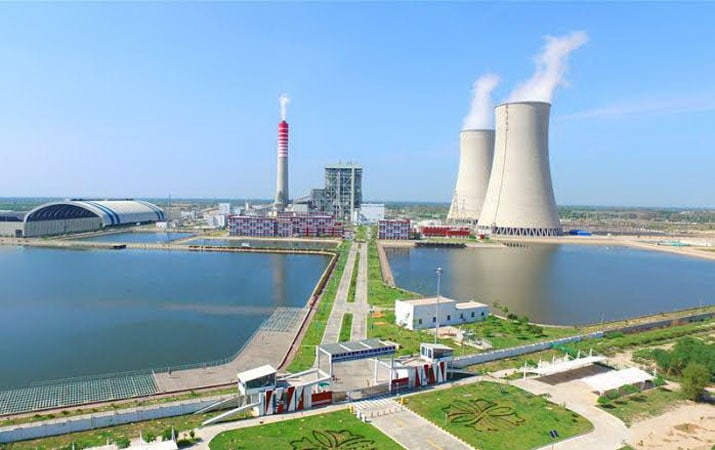At a critical juncture of time when Punjab is grappling to wriggle out of smog dilemma, Sahiwal coal-fired power plant built and operated under CPEC is keeping emission level at bare minimum level through advanced technologies such as Electrostatic Precipitators (ESP) and Flue Gas Desulfurization (FGD) systems.
These cutting-edge technologies effectively capture and remove particulate matter and sulphur dioxide from the exhaust gases, ensuring that emissions are significantly lower than the minimum standards set by Pakistan’s Environmental Protection Agency (EPA), the World Bank and Chinese regulations.
“Additionally, the plant has taken significant steps to reduce emissions within its own operations. One of the most effective and environmentally conscious strategies employed is the shift to electric vehicles for internal transport. The use of electric cart vehicles has been strictly mandated for moving personnel and goods within the plant premises, eliminating the need for fuel-powered vehicles that contribute to air pollution,” Sahiwal power plant media coordinator Umair Shahid said this during a research survey conducted by Institute of International Relations and Media Research (IIRMR) in collaboration with the environmentalists and university researchers.
“This transition to electric cars significantly reduces the emission of greenhouse gases, particulate matter and other air pollutants, helping to improve the overall air quality within the plant and in its immediate surroundings. The move not only addresses local pollution but also aligns with the plant’s broader commitment to sustainability and reducing its carbon footprint,” he replied to a question during the survey.
Moreover, survey revealed that the plant has embarked on an ambitious and ongoing plantation drive to increase the green cover within and around its premises. “This initiative is a vital part of the plant’s anti-smog strategy, as trees and plants play a crucial role in improving air quality. The plantation drive is carried out regularly, with employees actively participating in tree-planting activities creating a more environmentally friendly workplace. By increasing its green footprint, the Sahiwal Power Plant is contributing positively to its local ecosystem and setting a valuable example for other industrial entities to follow,” IIRMR survey laid bare the facts.
IIRMR research survey revealed that ensuring higher standards in maintaining best ecosystem, values of the hazardous gases of SO2 NOX, CO and mercury, Sahiwal coal-fired power plant which was built by Huaneng Shandong Ruyi (Pakistan) Energy (Limited) Sahiwal project a joint venture of Huaneng Shandong Power Generation Company and Shandong Ruyi Group, with an investment of about $1.8 billion, has been keeping lower than the emission values set by World Bank, Japan, EU since operationalization of plant in 2017 till date.
“It has also set up a Continuous Emission Monitoring System (CEMS) for monitoring the Particulate Matter (PM). In order to strengthen the Environmental Monitoring Protocols, Project Company has hired EPA Certified Third party Environmental Monitoring Company to follow Environmental Monitoring Plan (EMP) and submit monthly Environmental Reports. The Company has also installed Ambient Air Quality Monitoring Station to keenly monitor the air quality and to ensure quality air in accordance with NEQS,” survey said.
Survey in its in-depth report observed that in designing the coal yard, the company has paid special attention to environmental protection. The coal yard is equipped with water spraying guns to avoid coal dust. The catch fence is provided around the coal yard, which is 2m higher than the height of the coal pile. Ash yard is designed according to Chinese standards polyethylene geo-membrane (two cloth one membrane) of the design to (artificial barrier layer) has the equivalent permeability coefficient of 1.0×10-7cm/s and 1.5M thick clay layer to control seepage, survey said.
IIRMR survey made more revelation that 1320 MW Sahiwal Coal-Fired Power Plant, located in the heart of Punjab, Pakistan, has also recognized the critical need to save its employees from this ongoing smog threat. “One of the most significant measures introduced at the Sahiwal Power Plant is the mandatory wearing of protective masks by all employees working within the plant premises. During the smog season, all employees wear high-quality masks that are capable of filtering out harmful particulate matter (PM2.5) and other pollutants that are prevalent in smog. This measure is critical because exposure to these pollutants can lead to serious respiratory issues and exacerbate pre-existing health conditions. By ensuring that all workers are equipped with the necessary protective gear, the plant is prioritizing the health and safety of its workforce, while also setting an example for other industrial facilities in the region,” survey said.
Alongside these physical measures, the survey added that the plant has implemented a comprehensive educational program to raise awareness about the dangers of smog among its employees. “Regular lectures, workshops, and informational sessions are organized, where experts discuss the causes of smog, its health impacts, and practical ways to reduce exposure. The plant leadership, including senior executives like the CEO, CFO, Vice Presidents, and Chief Engineers, actively participates in these sessions, demonstrating their commitment to the cause, survey divulged.
For instance, a survey revealed that employees are encouraged to limit outdoor activities during peak smog hours, wear protective masks when necessary, and monitor air quality levels through available tools and apps. This proactive approach helps employees better understand the severity of the issue and empowers them to make informed decisions about their health and safety.
A further extension of the educational efforts is the plant’s “Preach to Friends and Family” policy, survey maintained. “The plant recognizes that addressing smog is not only a matter of workplace safety but also a public health issue that affects entire communities. As part of this initiative, employees are encouraged to spread awareness about the dangers of smog and the steps that can be taken to minimize exposure to their friends and family members. The plant provides employees with informational materials—brochures, pamphlets and videos—that they can share with their loved ones. This initiative aims to amplify the impact of the plant’s internal efforts by ensuring that the message about smog prevention extends beyond the workplace and into local communities,” it added.










